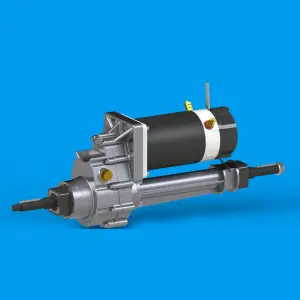The transaxle is a critical component in many modern vehicles, especially in front-wheel drive and all-wheel drive configurations. It combines the functions of the transmission and differential into a single integrated unit, helping to reduce weight and increase efficiency. Given its importance, keeping the transaxle in top condition is critical to the longevity and performance of your vehicle. One of the key aspects of transaxle maintenance is selecting the appropriate gear lubricant. This article will delve into the intricacies of transaxles and guide you on which transaxle gear lube to use.
What is a transaxle?
A transaxle essentially combines the transmission and differential into one unit. It is designed to transfer power from the engine to the wheels, while also managing gear ratios and torque distribution. This integration is particularly beneficial in front-wheel drive vehicles where space is at a premium. By combining these components, manufacturers can save space, reduce weight and improve the overall efficiency of the vehicle.
Why is gear lube important for transaxles?
Gear lube, also known as gear oil, plays a vital role in the proper operation of the transaxle. It has several key features:
- Lubrication: Gear lubricant can reduce friction between moving parts in the transaxle and prevent wear.
- Cooling: Helps dissipate the heat generated by gear friction and movement.
- Protection: Gear lubricants provide a layer of protection against corrosion and rust.
- CLEAN: Helps remove debris and contaminants from the gear system.
Given these functions, using the correct gear lubricant is critical to keeping your transaxle healthy and efficient.
Types of gear lubricants
There are many types of gear lubricants available, each with its own properties and applications. The most common types include:
- Mineral Oil Based Gear Lubricant: This is the traditional type of gear oil that is derived from crude oil. It’s usually cheaper, but may not offer the same level of performance as synthetic options.
- Synthetic Gear Lubricant: Synthetic gear lubricants are made from chemically engineered base oils and provide superior performance in temperature stability, oxidation resistance, and overall longevity.
- Semi-Synthetic Gear Lubricant: This is a blend of mineral and synthetic oils that provides a balance between cost and performance.
Viscosity grade
Gear lubricants are also classified by viscosity, which is a measure of the oil’s resistance to flow. The Society of Automotive Engineers (SAE) has established a grading system for gear oils, similar to the grading system for engine oils. Common viscosity grades of gear lubricants include:
- SAE 75W-90: A popular choice for many modern transaxles, providing good performance over a wide temperature range.
- SAE 80W-90: Suitable for mild climates and general use.
- SAE 85W-140: For heavy duty applications and high temperature environments.
Manufacturer recommendation
The first and most important step in choosing the right gear lubricant for your transaxle is to consult your vehicle’s owner’s manual. Manufacturers provide specific recommendations based on transaxle design and requirements. Using the recommended gear lubricant ensures you meet the specifications required for optimal performance and service life.
Factors to consider
When selecting gear lubricant for your transaxle, consider the following factors:
- Climate: The operating temperature range of the vehicle environment will affect the selection of gear lubricant. For example, synthetic gear lubricants are generally better suited for extreme temperatures.
- Driving Conditions: If you regularly drive in harsh conditions, such as off-road or in heavy traffic, you may need a gear lubricant with higher performance characteristics.
- Transaxle Life and Condition: Older transaxles may benefit from a different type of gear lube than newer transaxles. For example, on an older transaxle that has more wear and tear, a higher viscosity oil may be better.
Shift Lubricant
Regularly changing the gear lubricant in the transaxle is critical to maintaining its performance. Over time, gear lubricants can break down and become contaminated with debris and metal particles. Most manufacturers recommend changing gear lubricant every 30,000 to 60,000 miles, but this may vary based on vehicle type and driving conditions.
in conclusion
Choosing the right gear lubricant for your transaxle is critical to ensuring the longevity and performance of your vehicle. By understanding the different types of gear lubricants, their viscosity grades, and the specific needs of your transaxle, you can make an informed decision. Be sure to refer to your vehicle’s owner’s manual for the manufacturer’s recommendations, taking into account factors such as climate, driving conditions and transaxle age. Regular maintenance and timely gear lube changes will keep your transaxle running smoothly and efficiently for years to come.
Post time: Sep-20-2024


